Description and Requirements
The Book
Bibliography
Syllabus
 Introduction
Introduction The Great Pyramid
The Great Pyramid Music of the Spheres
Music of the Spheres Number Symbolism
Number Symbolism  Polygons and Tilings
Polygons and Tilings  The Platonic Solids
The Platonic Solids  Roman Architecture
Roman Architecture  Number Symbolism in the Middle Ages
Number Symbolism in the Middle Ages  The Wheel of Fortune
The Wheel of Fortune  Celestial Themes in Art
Celestial Themes in Art  Origins of Perspective
Origins of Perspective  What Shape Frame?
What Shape Frame?  Piero della Francesca
Piero della Francesca  Leonardo
Leonardo  Façade measurement by Trigonometry
Façade measurement by Trigonometry  Early Twentieth Century Art
Early Twentieth Century Art  Dynamic symmetry & The Spiral
Dynamic symmetry & The Spiral  The Geometric Art of M.C. Escher
The Geometric Art of M.C. Escher  Later Twentieth Century Geometry Art
Later Twentieth Century Geometry Art  Art and the Computer
Art and the Computer  Chaos & Fractals
Chaos & Fractals
NUMBER SYMBOLISM
in the
MIDDLE AGES
"But thou hast arranged all things by measure and number and weight."
Wisdom, XI, 20.

Slide 9-40: Chartres Cathedral
The great cathedrals are a symbol of the Middle Ages. By the Middle Ages numbers had acquired a metaphysical significance of their own, and were thought to be endowed with occult power. Thus they found their way into nearly every aspect of cathedral design, from the numbers of the pillars in the choir and layout of the facade, and, inevitably, to the division of the rose windows. In fact, the middle ages was nuts about numbers and geometry.
We've already looked at some roots in our unit on number symbolism: the Pythagoreans, astrology, the Old Testament, and mythology. Here we'll mention some new influences: the Cabbala and Gematria, the New Testament, neoPythagoreanism, neoPlatonism, Islam, alchemy, the Masons, Medieval magic, Tarot. As before, we'll do it by the numbers.
Lets look at the period starting with the fall of the Roman Empire, around 476 CE, up to the start of the Renaissance in Italy, about 1400 CE, a period called the Middle Ages.
Painton Cowan writes that by the Middle Ages numbers had acquired a metaphysical significance of their own, and were thought to be endowed with occult power. It was a time of religious ferment, including early Christianity with its symbolism, Judaism with the Caballa and Gematria, Zoroastrianism, and Mithraism. These religions that required extensive symbolism, because things like the nature of God and the Trinity, hard to explain in words, could be expressed symbolically. A Medieval scholar like St. Augustine could say, "No man can by force of will say that 3 times 3 is not nine." So number and geometry found their way into nearly every aspect of cathedral design, from the numbers of the pillars in the choir and layout of the facade, to the division of rose windows.
In fact, the middle ages was nuts about numbers and geometry. But where did this emphasis on numbers and geometry come from?
Many symbols were mathematical in origin because math was considered an absolute.
We've already looked at some roots in our unit on number symbolism: Astrology, the Pythagoreans, Plato, Mythology, and the Old Testament, where in the Apocrypha is the well-known line,
. . . thou hast arranged all things by measure and number and weight." Wisdom, XI, 20.
Here we'll mention some new influences: the Cabbala and Gematria, neoPythagoreanism, neoPlatonism, Islam, Alchemy, and the Masons, Medieval Magic, Tarot, and the New Testament, where Matthew wrote, "The very hairs of your head are all numbered" (Matthew, 10:30).
 |
Slide 8-3: Man in Sapphire Blue
Fox, Matthew. Illuminations of Hildegard of Bingen. Santa Fe: Bear, 1985. p. 22 |
Recall that for the Pythagoreans, one was the monad, the source of all other numbers, good, desireable, essential, indivisible. Pythagoras had much influence over Medieval philosophers such as Thomas Aquinas, who echoes the idea of one as a source. He wrote:
Since the soul is one and the powers are many; and since a number of things that proceed from one must proceed in a certain order; there must be some order among the powers of the soul.
But the number one is no longer an abstract first cause, as with the Pythagoreans, but is now the one God.
Two and Duality
We've seen earlier that two was the number of duality, opposites, and antithesis. To the Pythagoreans it was the Dyad, representing the Line, Diversity, a loss of unity, the number of excess and defect. It was their first feminine number.
Now in the Christian era, two became associated with
- the duality of the godhead: God the father, and Christ, and
- the two natures of Christ, human and divine.
Three and The Trinity
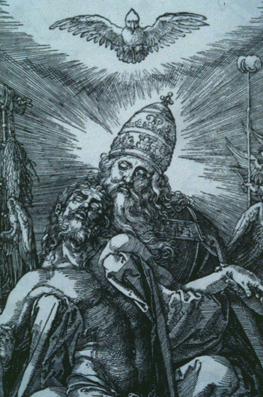 |
Slide 8-6: DURER: Trinity
Lehner, Ernst. Symbols, Signs & Signets. NY: Dover, 1950 p. 109 |
But, according to Vincent Hopper, this duality was a problem. Remember that three, as we saw in our earlier, was the traditional number of deity, for example, for the Babylonians and Egyptians and for the triple goddess. Hopper cites the early theologians Clement, Origen, and Hipolytus, who lived in Alexandria and were steeped in number symbolism, who wrote that the duality of the Godhead: God the Father, and Christ was one weakness of Christianity.
This was overcome by the creation of the trinity by the addition of the Holy Ghost, giving the Holy Trinity, Father, Son, and Holy Spirit: Three persons in one god, probably the most well known of all triads and a major art motif. The trinity is mentioned in Matthew 28,19:
Go ye therefore, and teach all nations, baptizing them in the name of the Father, and of the Son, and of the Holy Ghost:
Three Epochs
Three is sometimes equated to the three days Christ spent in the tomb, and to the three epochs of one world,
1. Before the law (Adam to Moses)
2. Under the law (Moses to Jesus)
3. Under Grace (Christ to Last Judgement)
Three Theological Virtues
 |
Slide 8-8: GUIDO RENI:Charity c. 1630.
Fisher, Sally. The Square Halo. NY: Abrams, 1995. p.102 |
Another trio from Christianity is Faith, Hope, and Charity. Its source is Paul's letter to the Corinthians, I Corinthians 13, 13.
And now abideth faith, hope, charity, these three; but the greatest of these [is] charity.
This trio can join our other trios of women; Three graces, three fates, three witches, three furies, three sirens, and also team up with Plato's four Justice, cardinal virtues, Prudence, Fortitude, Temperance, and to form the seven virtues.
The Triangle
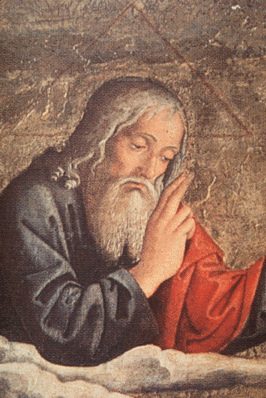 |
Slide 8-10: ANTONIAZZO ROMANO,
God the Father, detail. c. 1489.
Fisher, Sally. The Square Halo. NY: Abrams, 1995. p. 93 |
Most haloes are circular, but they come in other shapes as well. A triangular halo is used only for God the father, representing, of course, the trinity.
Four Evangelists
 |
Slide 8-17: Four Evangelists from Book of Kells
Mackworth-Praed, Ben. The Book of Kells. London: Studio, 1993. Plate XIII |
Groups of four in the New Testament include The Four Creatures of Revelation and The Four Horsemen of the Apocalypse. Also from the New Testament we have the four gospels written by the four evangelists; Matthew, Mark, Luke, and John. Three of them are often represented by animals; the ox for Luke, and the eagle for John, and the lion for Mark. Carl Jung says that the origin of the animal representations is Ezekiel 1, 5:
. . . of the midst there came the likeness of four living creatures. . . And . . . they had the likeness of a man. . . . And every one had four faces . . . the face of a man, and the face of a lion, on the right side: . . . the face of an ox on the left side; . . .they four also had the face of an eagle.
The Four Humours
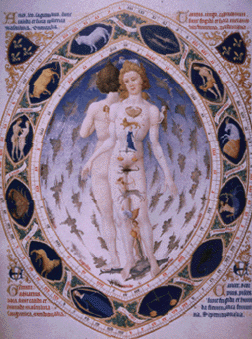 |
Slide 8-25: Zodiacal Man
Wasserman, James. Art and Symbols of the Occult. Vermont: Destiny, 1993. p. 13 |
In the middle ages much was made of the four humours; phlegmatic, sanguine, choleric, and melancolic (phlegm, blood, bile, black bile). This picture combines the humours with the qualities "hot, cold, moist, dry" with a set of three zodiac signs in the four corners, which are also the cardinal points of the compass.
| lower right | north | septentrionalia | Phlegmatic | sluggish, dull |
| lower left | south | meridionalia | Sanguine | hopeful, confident |
| upper left | east | orientalia | Choleric | hot-tempered, passionate |
| upper right | west | occidantalia | Melancolic | sad, depressed, melancholy |
The four humours were also types of personalities or temperaments
phlegmatic, calm, stolid temperament; unemotional
sanguine, begnign and gentle, Cheerful; optimistic
choleric, easily angered; bad-tempered; irritable.
melancolic, named for a daughter of Saturn, is also called saturnine.
The Cross
The number four relates to the cross, with its four extremeties, and to the square with its four sides. Both suggest the four directions or cardinal points. In both their members are perpendicular.
The cross is said to symbolize Cross-roads, that place in which all things meet, and from which all things are possible.
Five Stigmata
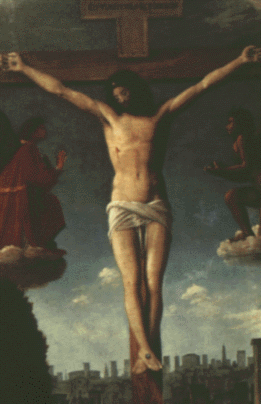 |
Slide 8-45: A Crucifixion
Christiansen, Keith. Italian Paintings. NY: Levin Assoc. 1992. p. 115 |
The cross is associated with the number 4, but also with the number 5, if the intersection is included. It symbolizes the four directions and here. This 5-point interpretation of the cross connects with the other main symbolism of five in Christianity, the number of wounds or stigmata received by St. Francis on Mt. Averna. It is the subject of many paintings.
The Pentagram
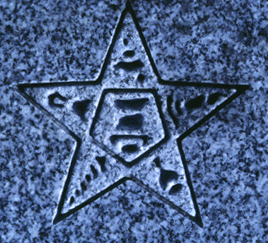 |
Slide 8-46: Tombstone showing
Order of Eastern Star Symbol.
Women's auxilliary of the Freemasons |
The geometric symbols of five are, of course, the pentagram and pentagon. As with the Pythagoreans, the pentagram was a symbol of recognition for certain secret societies, such as the Freemasons Flaming Star, and was supposedly on shield of Sir Gawain, one of the Arthurian Grail Knights.
Magic
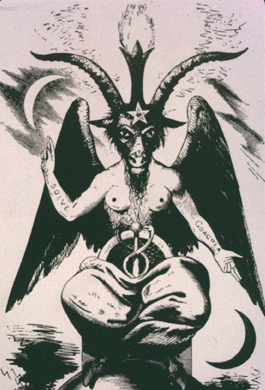 |
Slide 8-47: Baphomet, illustraton for
Transcendental Magic by Eliphas Levi, 1896.
Wasserman, James. Art and Symbols of the Occult. Vermont: Destiny, 1993. p. 70 |
Unlike the cross, the pentagram was almost exclusively for magic, but that magic was strengthened by reference to the cross and the stigmata. In medieval magic the pentagram was called the pentacle, and became a symbol for man, the microcosmos.
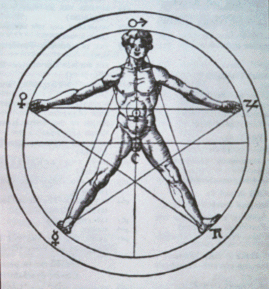 |
Slide 8-48: Symbolic representation
of man as Microcosmos. Agrippa.
Lehner, Ernst. Symbols, Signs & Signets. NY: Dover, 1950. p. 77 |
Flags
 |
Slide 8-52: Flags showing the pentagram |
The star pentagram appears on many flags. According to Betsy Ross' daughter, Washington and some others came to her mother's upholstery shop in Philly in June of 1776 with a rough draft of a flag. It had 6-pointed stars. Betsy showed them how to make a 5-pointed star by folding a piece of paper and making one cut with the shears. Washington then changed the design.
This story was later discredited. But it is interesting to note that George Washington studied engineering, geometry, trigonometry and surveying. His family crest contained stars and stripes, and some say that this may have influenced the flag design. Also, Washington was a Freemason.
...........................................................................................
Hands-On: Fold a pentagram by Betsy Ross' method.
 |
Slide 8-61: Gluttony
Art Bulletin. June 1996, p. 249 |
We've already mentioned Faith, Hope, Charity, the three Theological Virtues from I Corinthians in the New Testament, and Prudence, Fortitude, Temperance, Justice, the four Cardinal Virtues from Plato's Republic. These combine to make the Seven Virtures, one of the best-known heptads of Christianity.
To offset the virtues we have the Seven Vices, or Seven Deadly Sins, Gluttony, Lechery, Avarice, Luxury, Wrath, Envy, and Sloth. They are common art motifs.


Slide 8-67: GIOTTO: Scrovegni Chapel Frescos.
citation
The seven virtues and seven vices are sometimes shown in opposition. In the Scrovegni chapel, the Last Judgement shows God with his right hand palm up towards the saved, and along the right wall are the seven virtues. His left hand is palm down towards the damned, and along the left wall are the seven vices, each opposite its corresponding virtue.
| Prudence | vs | Foolishness |
| Fortitude | vs | Inconstancy |
| Temperence | vs | Ire |
| Justice | vs | Injustice |
| Faith | vs | Faithlessness |
| Hope | vs | Desperation |
| Charity | vs | Envy |
The seven sins are sometimes shown as the seven-headed dragon of Revelation 12:3, a favorite motif of Durer's.
Seven Gifts of the Holy Spirit
 |
Slide 8-58: LE MANS: Christ with Seven Gifts of the Holy Spirit
Male, Emile. The Gothic Image. NY: Harper, 1913. p. 167 |
Christianity has lots of groups of Seven. There are the Seven Sorrows of the Virgin and Seven Petitions of the Lord's Prayer. There are also seven gifts of the Holy Spirit, and Seven Joys of the Virgin, both popular art motifs.
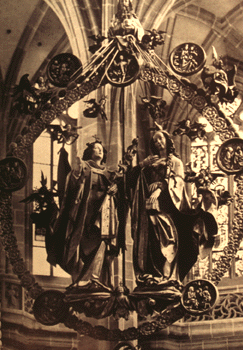 |
Slide 8-59: VEIT STOSS:
The Annunciation.1528, St. Lorenz, Nurnberg.
Busch, Harald et al. Renaissance Sculpture. NY: Macmillan, 1964. p. 107 |
Seven Liberal Arts
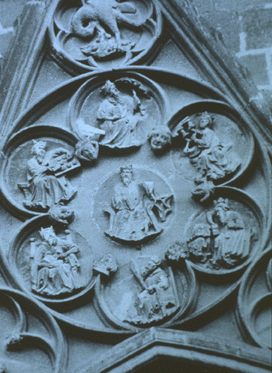 |
Slide 8-71: Seven Liberal Arts on a cathedral |
Throughout the Middle Ages, the seven arts represented the sum of human learning. The Medieval course of study consisted of:
The trivium, grammar, rhetoric, logic, for a Bachelor of Arts
degree, and
The quadrivium, arithmetic, music, geometry, and astronomy,
for a Master of Arts degree.
The quadrivium has its roots with the Pythagoreans, who gave us the very word Mathematics, and its branches.
The Seven Metals
Medieval alchemy identified seven metals. With their fondness for correspondences, these were assigned to the days of the week and the planets.
| Day | Symbol | Planet | Metal |
| Sunday |  |
Sun | Gold |
| Monday |  |
Moon | Silver |
| Tuesday |  |
Mars | Iron |
| Wednesday | Mercury | Mercury | |
| Thursday | Jupiter | Tin | |
| Friday |  |
Venus | Copper |
| Saturday | Saturn | Lead |
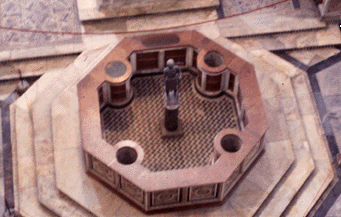 |
Slide 8-80: Baptismal font in Pisa |
Eight and the octagon represent resurrection and rebirth, because Christ rose from grave 8 days after entry into Jerusalem. Thus they became symbols of baptism, the spiritual rebirth of a person, and many baptistries and baptismal fonts are octagonal.
The Sacred Cut
An octagon can also be constructed in the following way:
Place a compass at each corner of a square and strike an arc which intersects the two adjacent sides and passes through the center of the square. This subdivides the square into a nine-module grid with modules of different proportions. Connecting the points where the arcs cut the square gives an octagon.
The Danish engineer Tons Brunes calles this construction the Sacred Cut. He claims it is the fundamental construction which forms the basis for system of geometry which has governed the construction of monuments in every period, from the Egyptian to the Medieval.
....................................
Hands-On: Construct an octogon by using the sacred cut.
 |
Slide 10-8: HILDEGARDE: Nine Ranks of Angels
Hildegarde, p. 74 |
Nine is called the angelic number, after nine choirs of angels. We just spoke about the Four Hierarchies of the Universe. One of which was the translunary world, including the moon and everything above. The translunary world is divided into nine spheres, the empyrium, the stars, and the seven planets. Each had its own kind of angel; seraphims, cherubims, archangels, and the lot.
We'll introduce them all in our unit on Celestial Themes in Art.
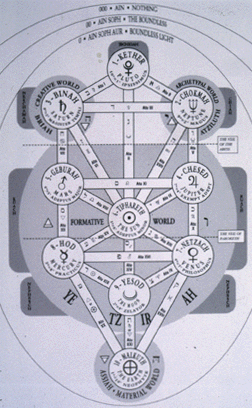 |
Slide 8-104: Kabbalistic Tree of Life.
Wasserman, James. Art and Symbols of the Occult. Vermont: Destiny, 1993. p. 33 |
In the Middle ages, we have the Ten Spheres of the Sephiroth. This figure also shows the Four Worlds that we discussed earlier, in light grey circles. It also shows the Sephiroth, which emanate or radiate from the divine power, each with its associated name, number and celestial body.
(1) Crown (2) Wisdom (3) Intelligence (4) Love(5) Justice (6) Beauty (or Mercy) (7) Victory or Firmness (8) Splendor
(9) Foundation (10) Kingdom
Because the sefiroth were considered archetypes for everything in the world of creation, an understanding of their workings were felt to illuminate the inner workings of the cosmos and of history.
Twelve Apostles
From the New Testament, the main appearence of twelve is, of course, the 12 Apostles, or disciples. They are a popular art motif; on cathedrals, the 12 disciples are often arranged in 4 groups of three.
This also relates twelve to seven: both are composed of 3 and 4, one by multiplication and one by addition, and both 7 and 12 are important astrological numbers.
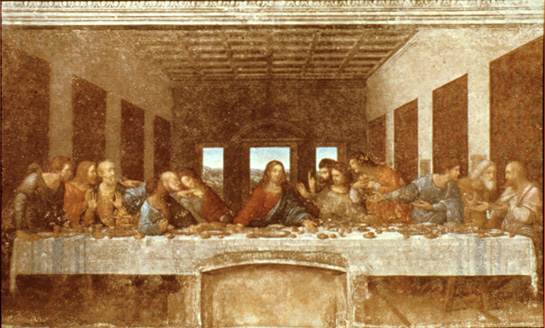
The number of faithlessness and betrayal, the number of the twelve apostles plus Judas.
Temptation of Jesus
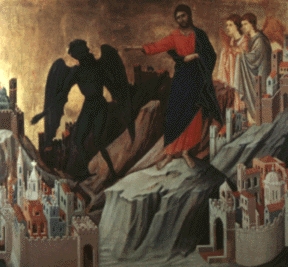 |
Slide 8-108: Duccio.
Fisher, Sally. The Square Halo. NY: Abrams, 1995. p. 69 |
Recall that forty was the number of trial and privation; days of the Great Flood, and the number of years Moses wandered in the desert. In the New Testament, after Jesus' baptism he was 40 days in the wilderness, tempted by the devil. The 40 days of lent commemorate this event.
666 - The Number of the Beast
Probably the best known number from the Bible is the mysterious number of the Beast of Revelation.
Rev. 13, 18: And here is wisdom. Let him that hath understanding count the number of the beast: for it is the number of a man; and his number is Six hundred threescore and six.
Some interpreted the beast as the antichrist, Nero, Mohammed, or the Pope. The theologian Peter Bengus wrote a 700 page book, mostly devoted to 666, which he found equivalent to the name of Martin Luther. Luther replied with an analysis equating 666 with the duration of the Papal regime and rejoiced that it was so near its end.
So into Alexandria, the great mixing bowl, were poured the symbolism of the Greeks Pythagoras and Plato, along with Old Testament, and Oriental Mysteries like cults of Isis and Osiris, and Mithraism, with their astrology and number lore.
Out of Alexandria came sects like the gnostics, and forms of mysticism like the Cabbala with its number lore of Gematria, and the New Testament, itself mostly lacking in number symbolism, but where the gnostics found numerical secrets later amplified by Augustine, Hildegard, and Aquinas.
All these sources, along with the geometry from Islam, impregnated the Middle Ages with number symbolism, and number lore flourished wherever cosmic secrets were valued, as in astrology, Medicine, alchemy, magic, and the Tarot.
As with our earlier units on number symbolism and the polygons, we're on shaky ground with things that are ambiguous and poorly documented, and capable of multiple interpretations. But as before, we have tried to focus on those things that hve come down to us in literature, and especially in art motifs. The geometry and number lore that permeated the Middle Ages could not help but affect the most prominent architecture, the Gothic Cathedrals, and the Masons, to be covered in upcoming units.
Hopper, Butler, Carr-Gomm, Ferguson, Koch, Lehner, Hall, Sill.
Projects
Fold a pentagram by Betsy Ross' method
Fold an octagon, NCTM constructions 44 and 48
Construct an octogon by using the sacred cut.
Do a semiregular tiling using the octagon as one of the elements.
Find out what is meant by each number in Green Grow the Rushes, Ho.
